
Original Link: https://www.anandtech.com/show/2448
ASUS P5E3 Premium: One to Rule them All…
by Kris Boughton on February 20, 2008 12:15 AM EST- Posted in
- Motherboards
As we reported earlier this month, most motherboard vendors' production schedules seem to indicate a mid-March release of Intel's next enthusiast-level X48 Express chipset. The rumor is that final silicon production is in full swing, and delivery to tier-one partners is occurring for product release in March - just in time for that lull between CeBIT and Computex. Recent delays in the release of X48 have given NVIDIA the breathing room they desperately need in order to prepare their upcoming 790i chipset, so we should see a near-simultaneous launch of the latest Intel based enthusiast offerings. History has shown us that even the smallest setback when it comes to the introduction of products intended to compete with a rival's new offerings can ultimately mean the difference between success and failure in the marketplace.
On one hand, NVIDIA knows their SLI technology has won the hearts and minds of a significant share of today's gamers and professional benchmarkers. Because of this, and somewhat against their will, Intel is forced to rely heavily on AMD's ability to positively establish their products as the leader in the high-performance graphics market. In the end, two major factors primarily determine which platform is "best" for the enthusiast: A) Just how well it ends up overclocking the latest processors and memory combinations, and B) graphics cards compatibility, including multi-GPU solutions. In an ideal world, we would be able to make our decision independent of the second point. Unfortunately, this has not been the case for some time now. NVIDIA's reluctance to extend SLI technology licensing to single-socket Intel platforms has resulted in a rather large conflict of interest for gaming enthusiasts worldwide - build around a less-than-stellar overclocking platform with amazing graphics performance, or forgo SLI altogether and concentrate on what we believe is a much more mature solution at this time, which only comes with owning an Intel chipset.
However, NVIDIA's day of reckoning is fast approaching. Their failure to open SLI to Intel chipset owners has made them less than popular in some circles, and with Intel just months away from introducing their next big platform interconnection technology (Quick Path), this could prove to be their undoing. Whether or not Intel offers NVIDIA a Quick Path license will effectively determine if NVIDIA's chipset development division will continue business as usual. Additionally, Intel's plans to soon enter the discrete graphics market, coupled with the possibility that NVIDIA may not receive a Quick Path license, may spell the end of SLI as we know it on the Intel platform in the near future.
If this scenario plays out, we would all likely be forced into a position where the purchase of a single component would then artificially limit some of the other hardware we could choose in order to complete our system builds. AMD would have their current Spider platform and next generation update, based on the combination of Phenom quad-core processors, AMD 7-series chipsets, and ATI Radeon 3800-4xxx series GPUs running in CrossFire (thanks to their late-2006 acquisition of ATI). Intel would offer next-generation Nehalem/Bloomfield CPUs on Quick Path motherboards, to be paired with one or more of their "Larabee" graphics cards. NVIDIA would be left to offer SLI support for their GPUs with 780/790 chipsets, and beyond that who really knows about the multi-GPU market. Without a doubt, there are interesting times ahead for this section of the market.
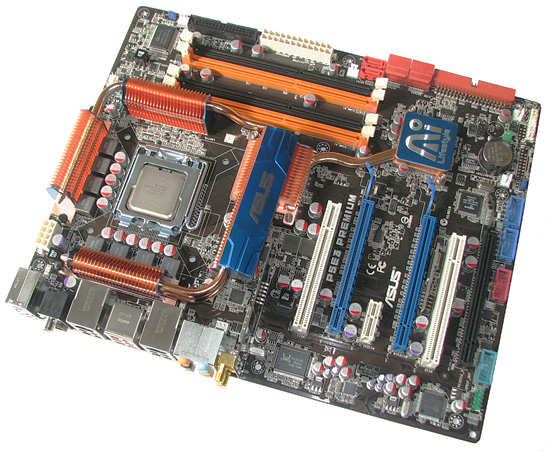 |
With Intel's X48 Express chipset launch less than one month away, ASUS has provided us with a near perfect sample of yet another great product for those looking to build their next ultimate overclocking system. Appropriately dubbed the "P5E3 Premium", this motherboard is much more than just a re-spin of their popular P5E3 Deluxe platform with the X48. The temptation for companies like ASUS to merely replace the X38 chipset with the pin-to-pin compatible X48 chipset and then remarket the board under a different name must be great. We would have a hard time giving a nod to the P5E3 Premium if this were the only change, especially to those that already own an X38 board. However, this is hardly the case. Simply looking over the board, we can find very few design layouts common to both the "Deluxe" and "Premium" variants of the P5E3. This is also reflected in the PCB revision silkscreened on the board, which has gone from 1.03G on the P5E3 Deluxe to 2.00G on the P5E3 Premium.
Some of the more notable improvements, which we will cover later in more detail, are the use of a 3-phase DDR3 memory power circuit as well as a 2-phase design for the MCH (Northbridge), something we have only previously seen on a few of the as-of-yet unreleased X48 boards from Gigabyte. We cannot say the decision to upgrade these power delivery systems surprises us; overclocking success is much more dependent on clean, reliable power lines than some might realize. Adding additional phases to a power regulation circuit is a great way to reduce the circuit's transient response time. For the user, this means the system is able to tolerate larger, faster total load changes, a crucial requirement in maintaining stability when components are being run well above their rated speeds. In addition, the extra current handling capabilities of the extra pair(s) of MOSFETs help to ensure the circuit does not become overloaded to the point of failure should an enthusiastic user decide to push their board far beyond recommended operating limits.
Although not directly marketed towards the extreme gaming crowd, the P5E3 Premium does well in that respect, matching other CrossFire solutions easily. Clearly, however, the focus is on overclocking and features. As with other X48 boards tested in this class, we had no problems running a 400MHz FSB stable overclock at stock MCH voltage (1.25V), which has become our somewhat de-facto test when it comes to judging a new board's worthiness to receive a more in-depth review. ASUS wisely chose to include their new MCH Read Delay adjustment BIOS features with this board, something we explored in detail in our ASUS ROG Rampage Formula review. They have also gone to great lengths to improve their CPU and Northbridge GTL (Gunning Transceiver Logic) tuning circuit implementations. Users now have the ability to tune GTL set points per die using much more precise stepping values (0.005x increments).
Now let's take a closer look at the design and layout of this board.
Board Layout and Features
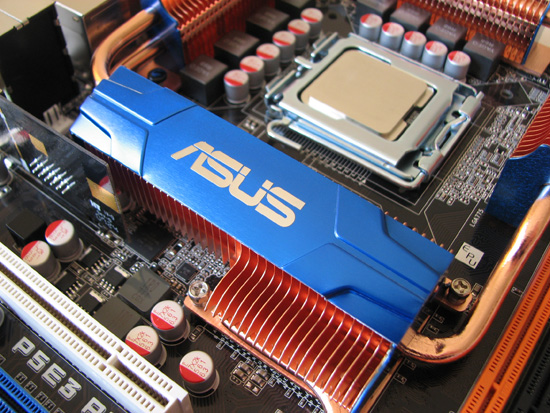
ASUS has managed to create an eye-catching board, from the all-copper cooling solution and the subtle blue tint on the LGA775 socket, to the tasteful expansion slot colors and the black PCB. If appearance is a major factor in your hardware purchases, the P5E3 Premium could be love at first sight; we were certainly impressed by the aesthetic balance. A quick and easy way to distinguish the Premium from the Deluxe (Intel X38 based) variants of the P5E3 series is the deep cobalt blue anodizing on the heatpipe covers and side supports. Although we try not to place too much weight on how a board looks, it's nice that users won't have to compromise with an ugly-but-fast board.
The single-piece heatpipe assembly is entirely capable of controlling Northbridge temperatures, even when pushing the board to its limits. ASUS has improved upon the already impressive mounting system by including screws that do not limit their travel to the point where the heat sink may feel "loose." The portions of the assembly covering the Northbridge and the Southbridge include back plates, a feature that allowed us the ability to ensure optimum heat transfer after we replaced the thermal interface material (TIM) with OCZ Freeze and gave the screws a few extra full turns. The heatsinks located above the power MOSFETs are still attached using plastic pushpins and flimsy metal springs - we would also like to see some black plates for these as hard mounting them would bow the board to the point that some of the components would no longer make proper contact with the heatsinks.
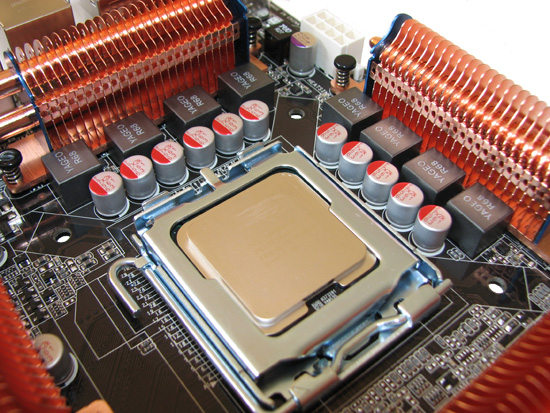
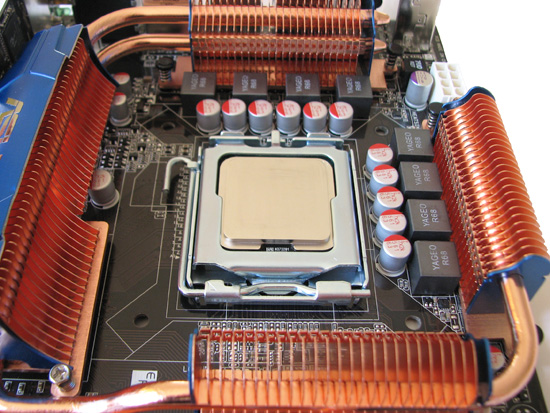
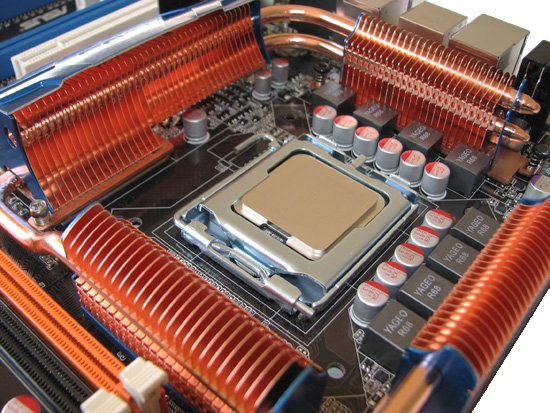
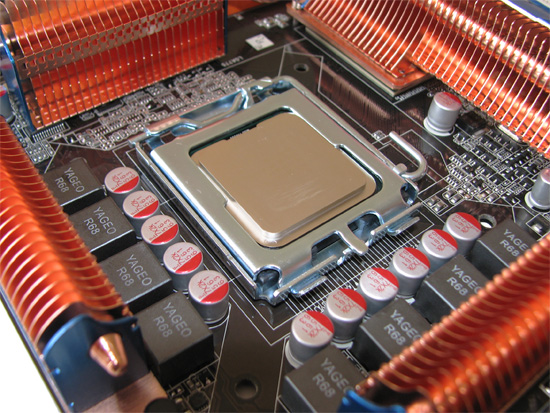
ASUS' power delivery system is among the best in the business at this time. An ADP3228 PWM controller commands an 8-phase solution, made up of low-DCR, solid ferrite-core Yageo inductors, and ultra-low ESR Nichicon capacitors. However, we feel that the two 270uF input power filter capacitors used to remove any ripple in the 12V line coming from the PSU were somewhat undersized for the task. We would like to see capacitors used here which provide at least 2000uF of total supply capacitance. The P5E3 Premium also includes an EPU (Energy Processing Unit), which functions to increase the VRM efficiency 7% by reducing the number of operating phases from eight down to four during periods of light system loading. However, given the incredibly low idle power consumption of Intel 45nm CPUs and G0-step 65nm CPUs, 7% usually works out to rather small savings. Don't expect to see a significant difference in power requirements from this feature alone. Regardless, every bit helps, so we applaud ASUS for their efforts.
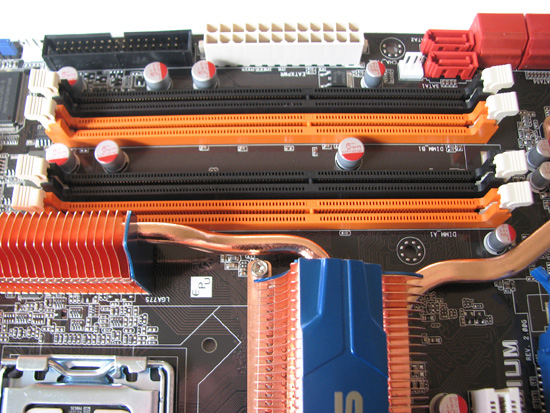
Here we can see the familiar trademark of DDR3 memory expansion slots - no on-board termination resistors. As an aside, one of the many improvements included in the change from DDR2 to DDR3 was the movement of motherboard-level termination resistors to the DIMM modules themselves. A closer look at any DDR3 module should reveal the presence of multiple arrays of 4-pack resistor SMDs used to terminate the command and data signal lines as close to the memory dies as possible. Not only does this improve overall signal integrity, allowing for stable operation at much higher memory speeds, but the memory power delivery solution can benefit as well. Fewer discrete components located near the DDR3 expansion slots means routing of power delivery (VDDQ) and ground planes can be made much cleaner - a fact ASUS takes advantage of by slightly widening the channel spacing to allow for the placement of extra bulk capacitance.
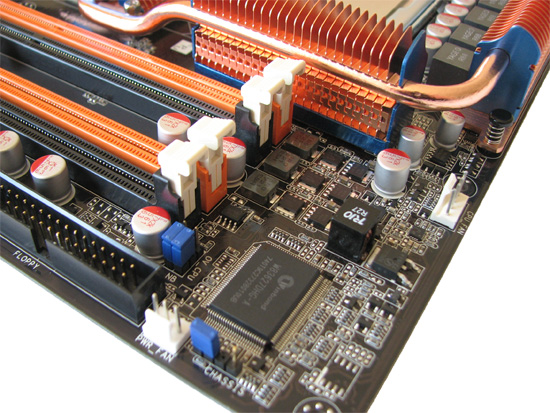
The changes don't end there though. ASUS' new P5E3 Premium is the world's first motherboard to employ a 3-phase memory power solution, shown in the above picture. Out of all the innovations introduced on this motherboard, this was by far one of our favorites. Strong, stable power delivery and solid reference voltages are vital in the success of any memory overclock and this board does not pretend otherwise. Worth noting, we measured the P5E3 Premium as overvolting the memory by about 0.05V with nearly no noticeable droop.
Also seen here are the "OV_CPU" and "OV_NB" jumpers, which select whether or not to allow the use of the higher, secondary voltage ranges available via the BIOS. Most if not all users should find they have no reason to change their positions, as they unlock what we would consider to be ridiculously high voltages. The Winbond SuperIO chip sits at the corner of the board.
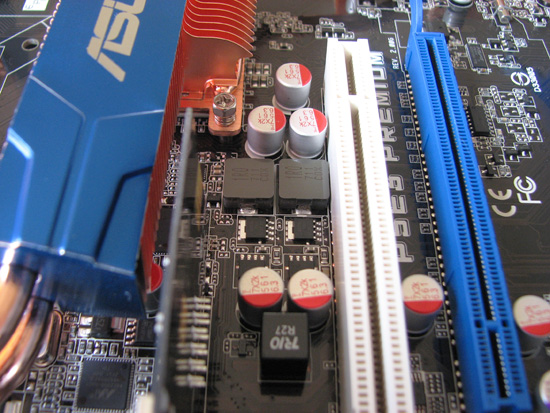
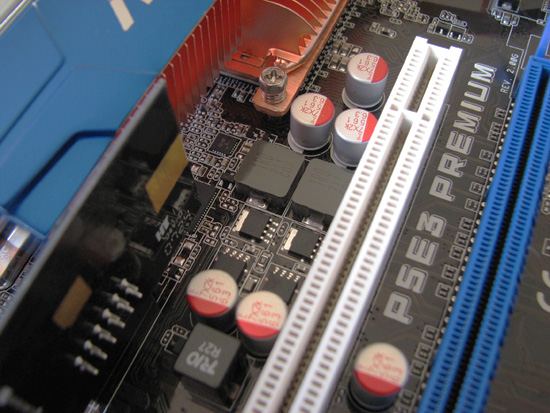
Not wanting to be left out, the Northbridge (MCH) is powered by a robust 2-phase system, something we have already grown to expect when it comes to the high-end X48 motherboards. ASUS' implementation is particularly interesting in that their solution utilizes the same exact MOSFETs used in both the CPU and memory power delivery circuits. Again, a clean, stable power supply is vitally important in any overclocking scenario. Our measurements showed the board overvolting the MCH by about 0.05V with about 0.01V of droop under load.
Board Layout and Features (Continued)
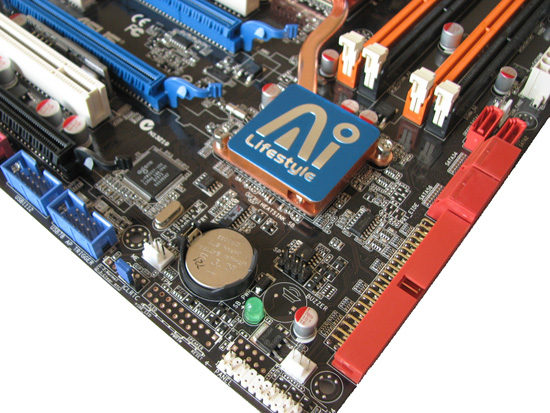
The hefty copper heatsink located atop the Southbridge is more than acceptable when it comes to controlling the temperature of the low-power ICH9R chipset; the Ai LifeStyle logo adorns the cover. As we mentioned earlier, the screw-mount system is great at allowing for maximum mounting pressure.
The battery is installed in an accessible location and the jumper seen below it can be used to reset the RTC (real time clock) without the need to remove the battery. The clear CMOS reset jumper is located right below the fan header, although the board is very capable of gracefully recovering should an overclock fail.
The single green LED is a power-on indicator, and the speaker pad seen just above it is empty as always - which makes us wonder why ASUS continues to design these into their boards but then never populates the area with a cheap buzzer. If not a cheap buzzer, then at least install the power on/off and reset buttons seen on the R.O.G. series of boards. We can also see two of the six fan headers, the other two being located along the middle horizontal axis of the board and the final two near the top.
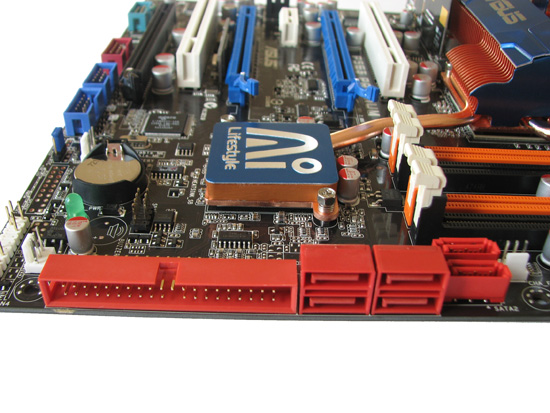
All six of the SATA 3.0Gbps ports seen here connect to the Intel ICH9R. The two vertical headers are ports 0 and 1, the other four 90-degree headers are ports 2 thorough 5. The single PATA header comes courtesy of a JMicron JMB363 controller, which also provides the eSATA ports located on the I/O panel.
The two dark blue header shrouds are for connecting extra USB 2.0/1.1 headers to the board. The red header is another IEEE 1394a port (the first is located on the I/O panel), controlled by the Agere chip placed above the battery. The light green header to the far back is for connecting a COM port extender cable, for those that still need one.
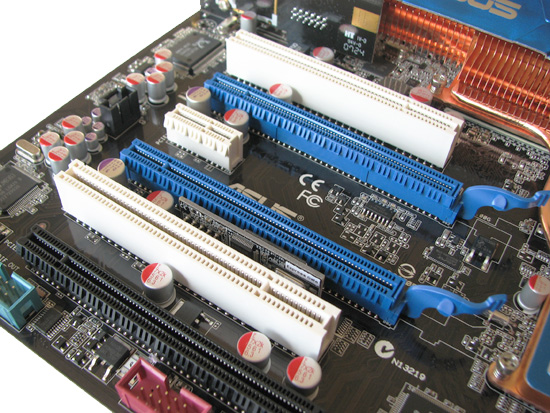
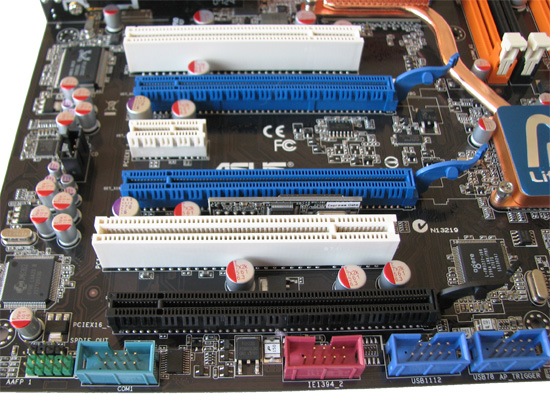
The X48 chipset offers two full x16 PCI-Express 2.0 expansion slots (blue) supporting CrossFire technology. The third PCI-Express x16 expansion slot (black) is PCI-E 1.x compatible and is only capable of training either x4 or x1 link speeds even though it can seat up to x16 cards mechanically. With no word yet if NVIDIA's recent acquisition of AGEIA might allow the use of a third video graphics card (such as the single-slot 8800GT), for now this slot may not need a GPU. Seeing as how NVIDIA has always been rather selective when it comes to allowing competitors the use of any of their multi-GPU technologies we can only imagine the answer is negative, Ghost Rider (the pattern is full). Perhaps NVIDIA (or AMD or Intel) will prove us wrong.
As with most DDR3 motherboards, the memory slots are further from the top of the board, locating them closer to the MCH. As a result, there is just barely enough room to install two graphics cards with dual-slot coolers, and doing so renders the only PCI-E x1 slot completely inaccessible. Unlike the P5E3 Deluxe, which features two PCI-E x1 slots, the Premium version lacks the upper slot due to the redesign of the MCH power regulation circuit. Perhaps a better decision would have been to locate one of the standard PCI slots here; that way the single PCI-E x1 slot and one of the two PCI slots would be available when running CrossFire with full-sized card coolers. In any case, we can see the importance of carefully planning for any future system expansion.
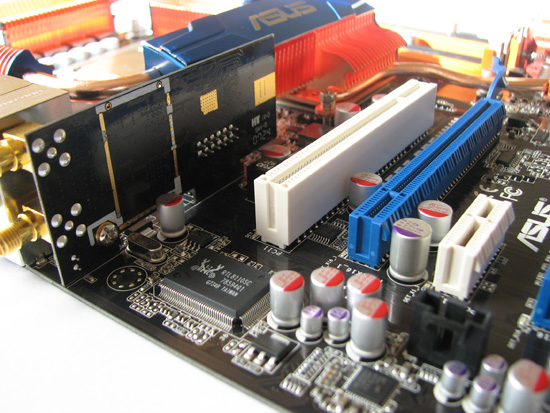
ASUS' proprietary WiFi-AP@n (is that the best name they could come up with?) expansion card brings full draft-N wireless functionality to the motherboard, a rather considerable bonus considering the cost of add-in cards. The unit connects via a hardwired USB interface, which is why the dual-homed card (two antennas) reduces the motherboard's USB capabilities from the standard 12 ports offered by the ICH9(R) to just 10.
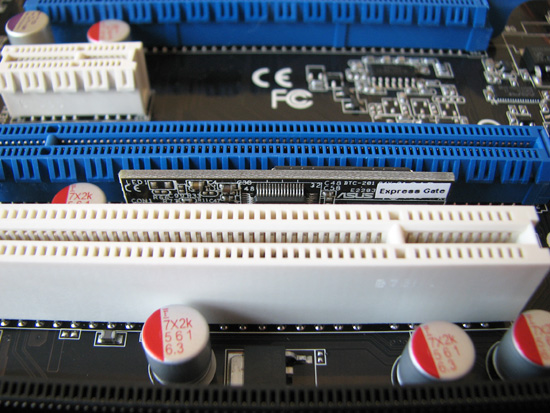
ASUS' Express Gate offers a unique quick-boot environment that allows you to almost instantly access commonly used functions like web browsing or communications applications without loading a traditional OS (operating system). We found the need to increase the selection timeout due to the long initialization time of our graphics card, without which we would usually miss the full screen logo display and our chance to invoke the option.
In our opinion though, Express Gate has one major flaw: while the included WiFi-AP@n connection can be used in this environment, it is only able to connect to WEP-encrypted networks and not the newer and much more secure WPA/WPA2 networks that should be used today. Not wanting to downgrade our network from WPA2 to WEP, we had to abandon hope of making normal use of this feature for now. However, it will do in a pinch in case you need to connect to the Internet for a BIOS update, driver download, or a quick check of the weather. Those that connect their system via Ethernet to a switch or router should not have any problems, as either LAN port can function in place of the wireless connection.
ASUS P5E3 Premium Specifications
| ASUS P5E3 Premium / WiFi-AP@n | |
| Market Segment | Premium / High-Performance - $279~$299 (estimated) |
| CPU Interface | Socket T (LGA775) |
| CPU Support | Any LGA775-based CPU, Core 2 Duo, Core 2 Extreme, or Core 2 Quad recommended, including next-generation 45nm CPU support |
| Chipset | Intel X48 Northbridge (MCH) with Fast Memory Access Technology and Intel ICH9R Southbridge |
| CPU Clock Multiplier | 6x ~ 11x, downward adjustable for Core 2, upward to 31x for Core 2 Extreme, including half-multiplier support for 45nm processors |
| Front Side Bus Speeds | Auto, 200 ~ 800 in 1MHz increments |
| System Bus Speeds | 1600 / 1333 / 1066 / 800 MHz and 2000 / 1800 MHz (OC) |
| DDR3 Memory Dividers | 1:1, 6:5, 5:4, 4:3, 3:2, 8:5, 5:3, and 2:1 (dependent upon strap selection) |
| FSB Strap | Auto, 200, 266, 333 and 400 |
| PCIe Speeds | Auto, 100MHz ~ 180MHz |
| PCI Speeds | Locked at 33.33MHz |
| DRAM Voltage | Auto, 1.50V ~ 2.78V in 0.02V increments, 1.50V (DDR3) standard |
| DRAM CLK/CMD Skew CA/CB | Auto, Manual (Advance/Delay 50ps ~ 350ps in 50ps increments) |
| DRAM Timing Control | Auto, Manual - 20 DRAM Timing Options (tCL, tRCD, tRP, tRAS, tRFC and 15 other sub-timings) |
| DRAM Command Rate | Auto, 1N, 2N |
| DRAM Static Read Control | Auto, Enabled, Disabled |
| DRAM Dynamic Write Control | Auto, Enabled, Disabled |
| Ai Clock Twister | Auto, Ligher, Light, Moderate, Strong, Stronger |
| Ai Transaction Booster | Auto, Manual |
| Common Performance Level | 1 ~ 31 (settings above 14 prevent POST) |
| CH A/B Phase Pull-In | Based on Memory Divider, All Phases Adjustable (Enabled/Disabled) |
| CPU Voltage | Auto, 1.10000 to 1.70000 in 0.00625V increments then to 2.1V w/OV jumper |
| CPU PLL Voltage | Auto, 1.50 ~ 2.78v in 0.02V increments, 1.50V standard |
| FSB Termination Voltage (VTT) | Auto, 1.20V to 1.50V in 0.02V increments, 1.20V (65nm CPU) or 1.10v (45nm CPU) standard |
| NorthBridge (NB) Voltage | Auto, 1.25V ~ 1.91V in 0.02V increments then to 2.21V w/OV jumper, 1.25v standard |
| SouthBridge (SB) Voltage | Auto, 1.05V ~ 1.20V in 0.15V increments, 1.05V standard |
| Clock Over-Charging Voltage | Auto, 0.70V ~ 1.00V in 0.10V increments, 0.80V standard |
| Load-Line Calibration | Auto, Normal, Performance |
| CPU GTL Voltage Reference | Auto, 0.370x ~ 0.760x in 0.005x increments, 0.630x standard (both dies) |
| NB GTL Voltage Reference | Auto, 0.61x ~ 0.67x in 0.06x increments, standard 0.67x |
| Memory Slots | Four 240-pin DDR3 DIMM Slots Dual-Channel Memory Architecture Regular Unbuffered, non-ECC DDR3 Memory to 8GB Total Supports Intel Extreme Memory Profile (X.M.P.) @ DDR3-1600, DDR3-1800 and DDR3-2000 |
| Expansion Slots | 2 - PCIe 2.0 x16 (blue), Supports AMD/ATI CrossFire Technology 1 - PCIe (1.x) x16 (black) @ x4 or x1 mode only 1 - PCIe (1.x) x1 2 - PCI Slot 2.2 |
| Onboard SATA RAID | 6x SATA 3.0Gbps Ports - ICH9R (Intel Matrix RAID 0,1, 5, and 10) |
| Onboard IDE/Additional SATA | Jmicron JMB363 PATA Controller (up to 2 UDMA 133/100/66 devices) 2x External eSATA ports - RAID 0, 1 and JBOD (SATA-On-the-Go) |
| Onboard USB 2.0/IEEE-1394 | 10 USB 2.0 Ports - (6) I/O Panel - (4) via Headers 2x Agere L-FW3227 IEEE-1394(a) Ports - (1) I/O Panel, (1) via header |
| Onboard LAN (with Teaming) | 1x Marvell 88E8056 PCI Express Gigabit Ethernet controller 1x Realtek RTL8110SC PCI Gigabit Ethernal controller |
| Wireless LAN (optional) | ASUS WiFi-AP@n (USB-based), 300Mbps Draft Wireless-N (Wireless-G/Wireless-B compatable), Software Access Point mode |
| Onboard Audio | ADI ADI1988B 8-channel HD Audio CODEC |
| Power Connectors | ATX 24-pin, 8-pin EATX 12V |
| I/O Panel | 1 x PS/2 Keyboard 2 x SPDIF - (1) Optical Out, (1) Coaxial Out 2 x External eSATA 1 x IEEE-1394a 2 x RJ-45 (LAN) 6 x USB 2.0/1.1 8-channel Audio IO 2 x WiFi-AP@n antenna jacks (optional) |
| Fan Headers | 6 - (1) CPU, (1) Power, (4) Chassis |
| BIOS Revision | 0145 (retail release) |
| Board Revision | 2.00G |

ASUS tells us they plan to introduce the board at a price point higher than the X38 motherboards available now, but lower than their R.O.G. series targeted at the serious gamer crowd. Aside from a couple of voltage and temperature monitoring features and the absence of some of the more "extreme" voltage options, the P5E3 Premium is very comparable to the Rampage Formula, which we reviewed in late January. For example, the MCH Read Delay (tRD) adjustments, first seen in the Rampage Formula BIOS, are also available with the P5E3 Premium.
At present, the only characteristic that we feel truly differentiates these two boards is the use of DDR3 with the P5E3 Premium, in place of DDR2 for the Rampage Formula. That being said, we think the P5E3 Premium - despite the need for more expensive memory - displays superior engineering; the 3-phase memory and 2-phase Northbridge power, along with Express Gate, draft-N wireless capabilities, and an attractive (and effective) cooling solution make it the motherboard to have… provided you can stomach the cost of DDR3. All that is left to be seen at this point is where exactly the Rampage Extreme, the DDR3 version of the Rampage Formula, will be priced with respect to other offerings if it is brought to market. If the P5E3 Premium is any indication, we expect more great things to come from ASUS.
With all the features packed into such a small package, the P5E3 Premium is positioned well to simultaneously capture the interests of the overclocking crowd as well as those looking for an all-in-one multimedia solution. The onboard ADI1988B 8-channel High Definition Audio CODEC (previously codenamed Azalia) produces excellent 24-bit/192kHz full surround sound that should please even the most discerning audiophile. The optical out or digital coaxial connections make interfacing with a DTS Connect (DTS Interactive and DTS NEO:PC) enabled system easy as well.
In addition, we found the external eSATA RAID capabilities very interesting. Although RAID 0 may not be the best choice when dealing with external SATA drives, the option of running either RAID 1 for data protection or JBOD - which gives to user the ability to combine two less expensive drives into a single, large logical drive - is an extra some will appreciate. Network Access Storage (NAS) drives are a wonderful way of storing information so that it can be access from anywhere on the network, but for those running a single system the ability to retain all your important files in one safeguarded location is a plus.
Memory Overclocking
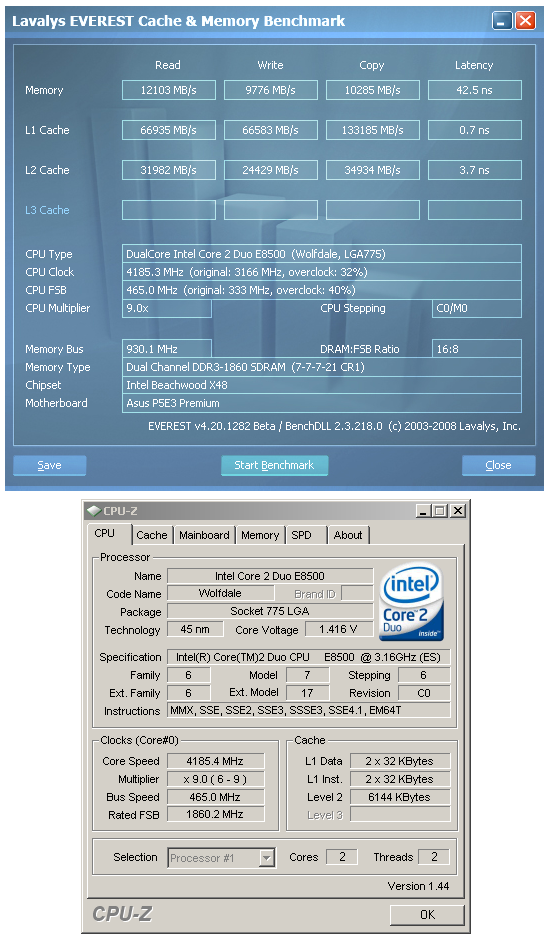
These are some of the highest memory read scores and lowest latencies we have ever seen on an Intel chipset. This is exactly where DDR3 starts to show its real power.
It's hard to argue with the performance potential this system brings at these settings, something that current X38 users might find impossible when aiming for total stability. Perhaps the most impressive point in this accomplishment is that our MCH required only 1.35V in order to run hour after hour of Prime95 or other stress tests without error. There are those that may believe this is not much to speak of, but the combination of high CPU speed and low tRD is brutal on the MCH - something we plan to explore soon in great detail. In fact, this is exactly where the X48 chipset begins to shine - in some of the situations where the X38 would either fall flat on its face or require voltages well in excess of those we feel comfortable using on a daily basis.
CPU Overclocking
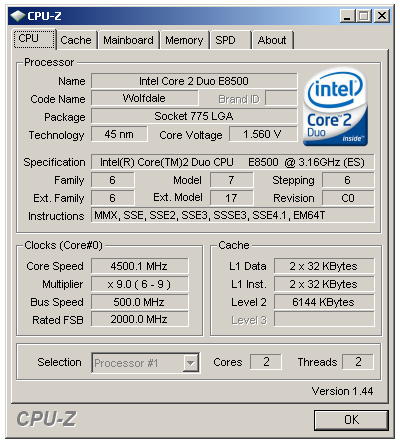 While 4.5GHz on a 45nm dual-core might not seem that impressive, we were able to get this system stable at these settings with water-cooling alone. Click to view Prime95 in action. |
The typical 45nm dual-core usually tops out around 4.0 to 4.2GHz on water-cooling or air-cooling alone, at least when it comes to achieving a truly stable overclock. Getting our E8500 sample to 4.5GHz stable took a little patience and a lot more Vcore than we feel comfortable using. Nevertheless, we ran Prime95 here for days while keeping temperatures under control (about 55C maximum in a 20C room). Most people who overclock knows just how difficult this can be.
Again, we must give a lot of credit in the success of this overclock to the power of the X48 chipset. This is also a great demonstration of ASUS' ability to design a very capable VRM circuit. Current draw under full-load at these speeds is impressive to say the least. Any other less capable power delivery design probably would have gone down in a blaze of glory (we had several in the labs that did just that trying to keep up with this board). This all just goes to show that although not specifically built for gaming per say, the P5E3 Premium is more than capable of keeping up with ASUS' very own R.O.G. line of motherboards. (Ed: Now if we could just do something about the lack of SLI….)
FSB Wars: Return of the Stupid-High Screenshot
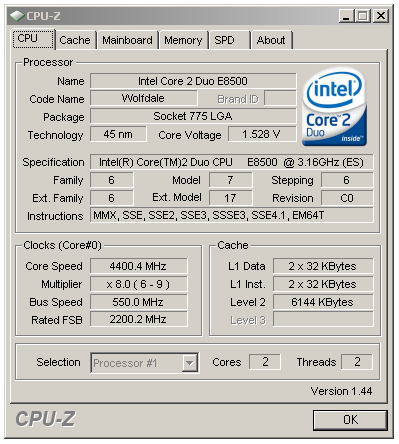
For the general bemusement of the FSB crowd, we decided to include a screenshot of our board's maximum FSB using stock cooling and respectable voltages. While higher FSB speeds may be achievable, we can hardly imaging using them at this point. Intel's 45nm dual-core speed binning process promises to play a much more active role in the release of all future CPUs. Those that think they are going to pay for a budget chip and then turn around and overclock it to the same speeds as top-end Extreme CPUs are in for a rude awakening based on our early retail results. Keep in mind that our absolute maximum stable overclock was barely made using a multiplier less than the E8500's stock 9.5x value and you should begin to see one reason why these uber-high FSB speeds are just plain unneeded.
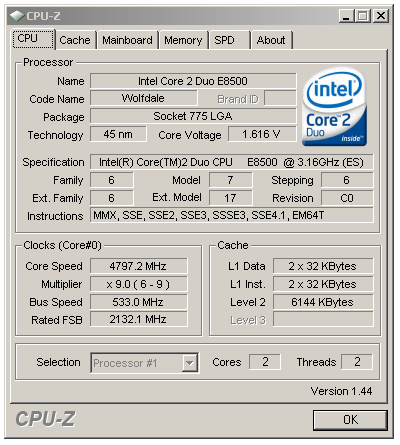
No quick look at overclocking performance would be complete without the obligatory maximum CPU frequency suicide-run screenshot. Just what the maximum achievable frequency was had more to do with our nerves than anything else. Given the voltage, our E8500 was more than happy to continue scaling ever higher. At some point though we said enough is enough and called it quits - that point came when we saw that we were subjecting our poor 45nm CPU to over 1.6V, simply a voltage that will require your credit card to be handy for another CPU in short time. Quite simply, we believe any voltage over 1.45V is asking for danger on the 45nm processors and conversations with Intel seem to back-up our beliefs right now. Our only solace is that we were quick when it came to gathering these results.
Initial Thoughts
As March approaches, the question on most enthusiasts' minds is going to be whether to go with Intel's next extreme performance desktop chipset, the X48, or NVIDIA's upcoming DDR3 chipset, the 790i. While it would be premature for us to answer this question, considering that NVIDIA has yet to send out samples for review, we can't help but be pleased by the performance increases we have seen recently with the X48 chipset. When properly paired with DDR3 memory, the X48 is capable of memory read and write speeds normally reserved for the likes of AMD with their on-die controller. All that remains is to see if NVIDIA can match these speeds and stability.
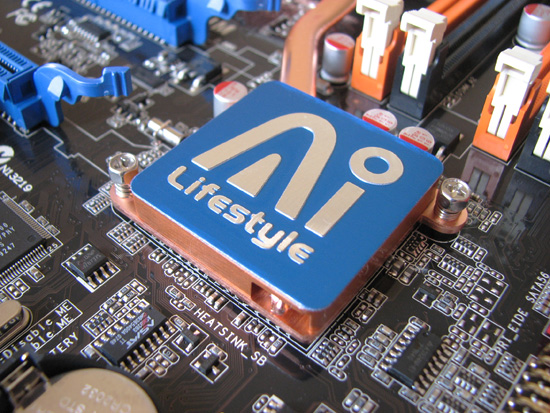
The ASUS P5E3 Premium BIOS already looks good - plus the board just works. We have exercised just about every possible combination of settings and options with a variety of hardware and have come up with no more than a few small concerns worth mentioning. Lately, ASUS has consistently led the pack when it comes to BIOS preparation, testing, and qualification, and it shows here as well. Look for "premium" performance from this truly impressive board when we pit it head-to-head next month against some of the latest X38 and X48 motherboard offerings. While we are respecting the wishes of Intel in not providing absolute benchmarks in a variety of applications, all we can say is that this board led all others overall. With the extra time afforded by the latest launch delay, we are completing further testing with our Wolfdale processors.
To be brutally honest about the current market situation, ASUS has almost entirely swept the field lately when it comes to producing high-performance motherboards based on the X38 or X48 chipset. We hope other companies like DFI, Foxconn, Gigabyte, or abit have an ace up their sleeves and are polishing the cannonball as much as they can before next month's X48 launch. If we had to speculate, we would attribute a lot of ASUS' recent success on their decision to listen - really listen - to what the typical overclocker wants to see in a motherboard. Here's to hoping they keep it up.
 |
ASUS has also worked hard to make owning a high-end X48 motherboard some what affordable. With an estimated retail price of around $299, there is a lot of value in the purchase of the P5E3 Premium for those looking at a high-end motherboard to use in the coming years. You get one of the best sounding audio solutions we have ever heard in an integrated chipset, plus built-in draft-N wireless connection with access point (AP) capabilities. Those two items alone account for at least $100 - provided you use them, naturally. We won't go so far as to call the P5E3 Premium inexpensive, because it's not. However, it provides an overall experience you just can't match with a $100 motherboard, and if you're planning to overclock a Penryn CPU you definitely don't want to skimp when it comes to motherboard quality. All you need to do now is wait for X48 boards to officially launch, which should thankfully occur within the next month (believe us, we are tired of the previews and constant retesting also).







